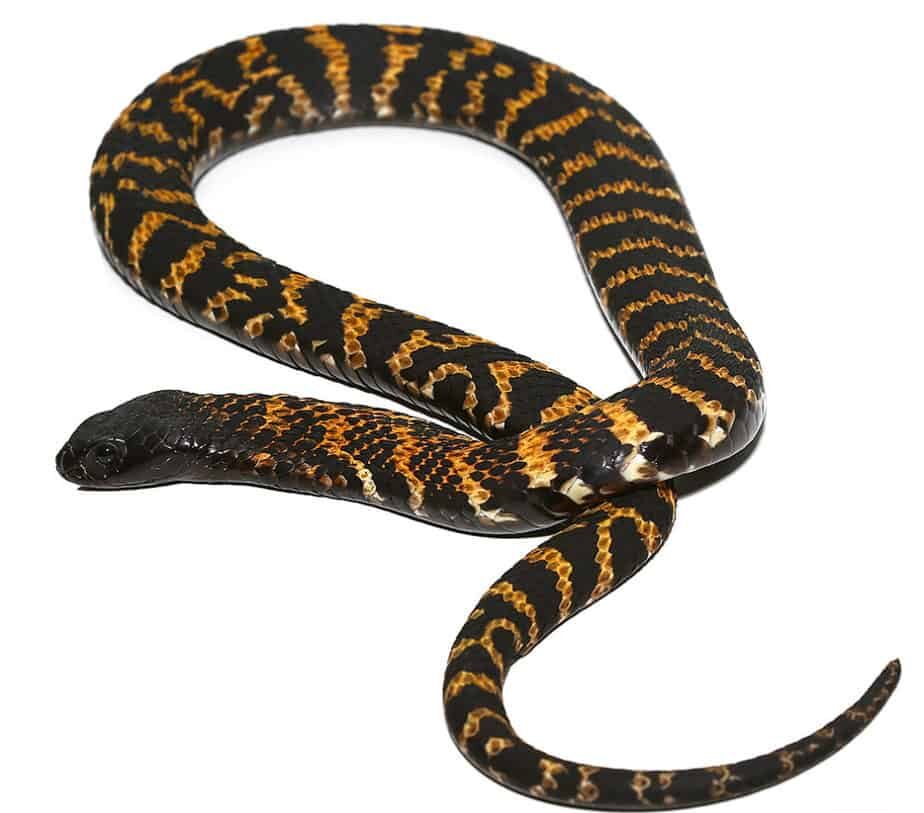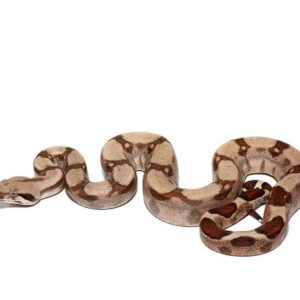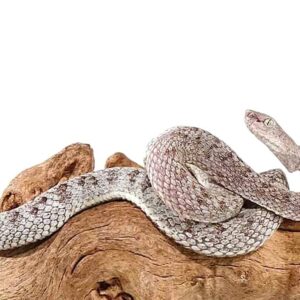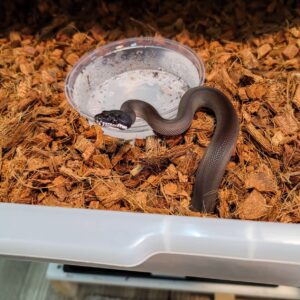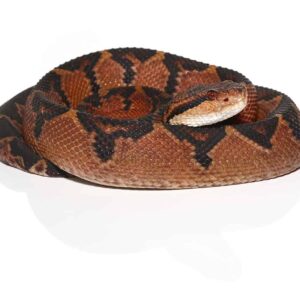Rinkhals Spitting Cobra For Sale
$499.99
WE HAVE Rinkhals Spitting Cobra FOR SALE. HERE ARE SOME HIGHLIGHTS:
- Hemachatus haemachatus
- Also Called The Ring-Necked Spitting Cobra
- Captive Bred
- Approximately 24 – 36 Inches
- Can Grow Up To 3 – 5 Feet
- Feeding On Rat Pups or Rat Crawlers Regularly
- *These Are Venomous. Please Know Your State Laws Before Inquiring As Some States Require Venomous Permits*
FUN FACTS!
- The Rinkhals Spitting Cobra Can Spray It’s Venom Up To 2.5 m.
- It Is A Very Quick, Extremely Agile, And Alert Snake
- Rinkhals Spitting Cobra Also May Live In Swamps Around Southern Africa
- They Prefer Grassland Habitats, It Allows Them To Blend In With Their Surroundings
- With Proper Care These Snakes Can Live 10 – 12+ Years In Captivity
Description
The Rinkhals spitting cobra, scientifically known as Hemachatus haemachatus, is a fascinating species of elapid snake native to Southern Africa. Unlike many other cobras, the Rinkhals exhibits unique characteristics that set it apart within the serpentine world. Commonly referred to as the Ring-necked spitting cobra due to the distinctive ring-like markings around its neck, the Rinkhals Spitting Cobra is known for its ability to spit venom as a defense mechanism. This adaptive trait is particularly effective in deterring potential predators and providing a fascinating study subject for herpetologists and snake enthusiasts alike.
Classified under the family Elapidae, the Rinkhals is not a true cobra despite its common name and certain shared behaviors. One of the most striking features of the Rinkhals is its ability to feign death when threatened, a behavior uncommon among other elapids. This snake’s physical appearance includes a dark body often adorned with white or yellow bands, giving it a distinctive look that aids in identification. Such coloration not only serves as a warning to predators but also adds to the snake’s allure in the eyes of those who study it.
The Rinkhals spitting cobra’s venom, while potent, is primarily cytotoxic, causing severe tissue damage and pain rather than neurotoxic effects typical of other elapids. This characteristic further distinguishes the Rinkhals, making it a unique subject of medical and ecological research. Its habitat preferences include grasslands, wetlands, and open woodlands, where it plays a crucial role in the ecosystem by controlling the population of small mammals and other prey.
Understanding the Rinkhals spitting cobra’s biology and behavior is essential for appreciating its role in nature and the challenges it faces in a changing environment. As we delve deeper into the world of this remarkable snake, its unique features and adaptations will become even more apparent, shedding light on why the Rinkhals is an intriguing subject of study.
Habitat and Distribution
The Rinkhals Spitting Cobra, scientifically known as Hemachatus haemachatus, exhibits a distinct preference for specific habitats within its geographical range. Primarily found in the southern regions of Africa, their distribution spans across South Africa, Eswatini (Swaziland), and Lesotho. These serpents thrive in diverse environments, notably grasslands, savannas, and wetlands, which provide the optimal conditions for their survival and proliferation.
Grasslands present a favorable habitat for the Rinkhals due to the abundant cover and ample prey, including rodents and amphibians. The tall grasses offer excellent concealment from predators and a strategic vantage for ambushing prey. Savannas, characterized by their scattered trees and open landscapes, also support a substantial population of Rinkhals. The balance of vegetation and open spaces in savannas facilitates effective hunting and thermoregulation, crucial for ectothermic creatures like the Rinkhals.
Wetlands, including marshes and swamps, are another critical habitat for the Rinkhals Spitting Cobra. These water-rich environments not only provide a steady supply of prey like frogs and small mammals but also aid in maintaining the snake’s hydration levels. The Rinkhals often exhibit semi-aquatic behavior, leveraging the wetland terrain for both hunting and evasion from threats.
The specific habitat preferences of the Rinkhals significantly influence their behavior and distribution. The availability of prey and the structural complexity of their environment dictate their hunting strategies and movement patterns. In regions where grasslands and wetlands overlap, Rinkhals populations tend to be denser, benefiting from the diverse prey base and varied cover. Conversely, in predominantly dry and arid areas, their numbers dwindle, underscoring the importance of habitat diversity for their survival.
Understanding the habitat and distribution of the Rinkhals Spitting Cobra is essential for conservation efforts. Protecting and preserving their natural environments ensures the sustainability of their populations and the ecological balance within these regions. By appreciating the intricate relationship between the Rinkhals and their habitats, we can better address the challenges they face in an ever-changing landscape.
Physical Characteristics
The Rinkhals spitting cobra, scientifically known as Hemachatus haemachatus, is a unique member of the Elapidae family, distinguished by several notable physical characteristics. Typically, an adult Rinkhals Spitting Cobra measures between 1.2 to 1.5 meters in length, although some individuals can reach up to 1.8 meters. This size range is relatively moderate compared to other cobra species, making the Rinkhals Spitting Cobra neither the largest nor the smallest in the cobra family.
One of the most striking features of the Rinkhals is its distinctive coloration and banding pattern. The dorsal side of the snake exhibits a dark, often black or brown base color, interspersed with white or light-colored crossbands. These crossbands are more pronounced in younger snakes and tend to become less distinct as the snake ages. This banding provides an effective camouflage in its natural habitat, which includes grasslands, savannas, and fynbos regions in southern Africa.
Unlike true cobras, the Rinkhals displays a unique physical trait – keeled scales. These scales have a ridge running along their length, giving the snake a rougher texture compared to the smooth scales of other cobras. Another distinguishing characteristic is the presence of a hood, which the Rinkhals can expand when threatened. The hood, along with its ability to spit venom, is a defense mechanism shared with other spitting cobras. However, the Rinkhals differs in its hood shape, which is less pronounced and more rounded compared to the broader, more fan-shaped hoods of true cobras like the Indian cobra (Naja naja).
Furthermore, the Rinkhals is capable of playing dead, an unusual behavior not commonly seen in other cobra species. When threatened, it may roll onto its back, open its mouth, and stick out its tongue, mimicking the appearance of a dead snake. This behavior, combined with its physical attributes, makes the Rinkhals a fascinating subject of study in the world of herpetology.
Behavior and Diet
The Rinkhals Spitting Cobra, known scientifically as Hemachatus haemachatus, exhibits a range of fascinating behaviors that set it apart from other snake species. Its behavioral patterns are closely linked to its hunting strategies and dietary preferences. Primarily a nocturnal hunter, the Rinkhals actively seeks out prey during the coolness of the night, which aids in its stealth and efficiency. By leveraging its keen sense of smell and heat-sensing pits, the Rinkhals can accurately locate and strike its prey even in the dark.
In terms of diet, the Rinkhals displays a diverse palate. Amphibians, such as frogs and toads, constitute a significant portion of its diet. These amphibians are often abundant in the Rinkhals’ natural habitats, making them easily accessible prey. Additionally, the Rinkhals preys on small mammals, including rodents like mice and shrews. These creatures provide essential nutrients that fuel the snake’s active lifestyle. Other reptiles, including smaller snakes and lizards, also fall victim to the Rinkhals’ predatory tactics.
The Rinkhals employs a unique method of capturing its prey. Unlike some other cobra species that rely solely on venom, the Rinkhals combines its venomous bite with constriction to subdue its prey. This dual approach ensures a higher success rate in immobilizing and securing its meal. The venom of the Rinkhals is primarily neurotoxic, affecting the nervous system of its prey and leading to paralysis. This venom is also used defensively, with the Rinkhals capable of spitting it accurately at a perceived threat from a distance of up to 2.5 meters.
Daily activities of the Rinkhals are influenced by environmental conditions. During cooler months, it may enter a state of brumation, similar to hibernation, to conserve energy. Conversely, in warmer periods, it is more active and frequently engages in basking to regulate its body temperature. Understanding the behavior and diet of the Rinkhals Spitting Cobra provides valuable insights into its ecological role and adaptations.
Venom and Spitting Mechanism
The Rinkhals Spitting Cobra, scientifically known as Hemachatus haemachatus, possesses a unique venom delivery system that distinguishes it from many other serpents. Unlike most snakes that inject venom through bites, the Rinkhals can project its venom accurately at targets up to two meters away. This adaptation serves as both a predatory tool and a formidable defense mechanism.
The venom of the Rinkhals is a complex cocktail of neurotoxins and cytotoxins, designed to immobilize prey and deter predators. Upon contact with the eyes, the venom can cause intense pain, inflammation, and temporary or even permanent blindness if not promptly treated. This targeted spitting mechanism is an evolutionary advantage that allows the Rinkhals to defend itself from a safe distance, reducing the risk of injury from larger predators.
Biologically, the Rinkhals has specialized fangs with modified orifices that enable this spitting action. The fangs are positioned forward in the mouth, allowing the snake to exert pressure on its venom glands to forcefully eject the venom. This adaptation is shared with other spitting cobras, such as the Black-necked Spitting Cobra (Naja nigricollis) and the Mozambique Spitting Cobra (Naja mossambica). However, the Rinkhals is noted for its remarkable accuracy and the consistency of its spitting mechanism.
Comparatively, while all spitting cobras utilize a similar method, the Rinkhals exhibits a unique behavior known as hooding and feigning death. When threatened, it spreads its hood, mimicking typical cobra behavior, and if further provoked, it may fall to the ground and play dead. This combination of defensive tactics makes the Rinkhals an intriguing subject of study within the realm of herpetology.
Understanding the venom and spitting mechanism of the Rinkhals is essential for both ecological research and medical treatment. The study of these adaptations not only provides insight into the survival strategies of the Rinkhals but also informs the development of antivenoms and medical protocols to treat envenomation effectively.
Reproduction and Lifespan
The reproductive cycle of the Rinkhals spitting cobra, a fascinating aspect of its biology, begins with mating behaviors that typically occur in the warmer months. During this period, males engage in combat, often wrestling to establish dominance and earn the right to mate. This ritualistic behavior is crucial for ensuring that only the fittest males pass on their genes. Once a dominant male has secured a mate, the actual mating process takes place, which can last several hours.
Following successful copulation, the female undergoes a gestation period that generally spans between three to four months. Unlike many other snakes, Rinkhals are ovoviviparous, meaning they give birth to live young rather than laying eggs. This unique adaptation provides a higher likelihood of survival for the offspring, as they are less vulnerable to predation during the vulnerable egg stage. At the end of the gestation period, the female gives birth to a litter ranging from 20 to 35 young, each fully equipped to begin their independent lives immediately.
The lifespan of the Rinkhals spitting cobra varies significantly between wild and captive environments. In the wild, these snakes face numerous threats, including predation, habitat destruction, and disease, which generally result in a shorter average lifespan of approximately 10 to 12 years. However, in captivity, where they are provided with consistent food supply, medical care, and a controlled environment, Rinkhals can live up to 20 years or more. Factors such as diet, stress levels, and overall care play a critical role in influencing their longevity.
Understanding the reproductive and lifespan characteristics of the Rinkhals not only enriches our knowledge of this remarkable species but also underscores the importance of conservation efforts to protect their natural habitats. By ensuring a stable environment, we can aid in their survival and continue to study their intriguing behaviors and lifecycle.
Interaction with Humans
The Rinkhals spitting cobra, known scientifically as Hemachatus haemachatus, is a species of venomous snake often encountered by humans in southern Africa. Though not aggressive by nature, it can pose significant dangers if provoked or threatened. Understanding the frequency of these encounters and the associated risks is crucial for safe coexistence.
Encounters with Rinkhals are relatively common in rural and suburban areas where their natural habitat overlaps with human activity. These snakes are frequently found in grasslands, wetlands, and even gardens, leading to occasional confrontations with people. Despite their intimidating appearance and defensive behavior, Rinkhals typically prefer to avoid humans and will only exhibit aggression if they feel cornered or threatened.
The potential danger posed by Rinkhals arises primarily from their venom, which they can deliver through bites or by spitting. The venom contains cytotoxins and neurotoxins, which can cause significant medical issues. Bites can lead to pain, swelling, and tissue damage, while venom sprayed into the eyes can result in severe irritation, temporary blindness, and corneal damage if not promptly treated. It is essential to seek immediate medical attention in the event of a bite or venom exposure to the eyes to mitigate the potential health risks.
To safely coexist with Rinkhals, it is imperative to take certain precautions. Avoid tall grass and dense vegetation where these snakes may be hiding, and always wear protective clothing such as boots and gloves when working in areas where Rinkhals are known to inhabit. Educating local communities about the presence of these snakes and the importance of not provoking them can significantly reduce the likelihood of dangerous encounters. Furthermore, creating a snake-friendly environment by minimizing rodent populations, which attract Rinkhals, can also help in reducing their presence in human-populated areas.
Conservation Status and Efforts
The Rinkhals spitting cobra, a species native to Southern Africa, faces several significant threats that have led to its current conservation status. Predominantly, habitat loss due to expanding agricultural activities and urbanization poses a severe risk to their population. As natural habitats are converted into farmland or urban areas, the Rinkhals spitting cobra’s living space diminishes, leading to a decline in their numbers.
Furthermore, human activities such as poaching and the illegal pet trade also contribute to the decline of this species. These snakes are often killed on sight due to fear and misunderstanding of their behavior, despite their ecological importance. The collection of Rinkhals for their skin or as exotic pets further exacerbates their vulnerable status.
In response to these threats, several conservation measures have been implemented to protect the Rinkhals spitting cobra. These efforts include habitat preservation initiatives, which aim to safeguard and restore the natural environments where these snakes thrive. Protected areas and wildlife reserves play a crucial role in providing safe havens for the Rinkhals, allowing them to live and reproduce without the imminent threat of human encroachment.
Education and awareness campaigns are also vital components of conservation efforts. By educating local communities about the ecological significance of the Rinkhals spitting cobra and promoting coexistence, these campaigns aim to reduce the instances of snake killings and promote a more harmonious relationship between humans and wildlife. Additionally, stricter regulations and enforcement against poaching and the illegal pet trade are essential to curb these detrimental activities.
Overall, the concerted efforts to protect the Rinkhals spitting cobra underscore the importance of preserving their natural habitats and ensuring their survival. By addressing the primary threats and promoting conservation initiatives, there is hope that this unique species will continue to thrive in the wild, contributing to the biodiversity and ecological balance of their native regions.


